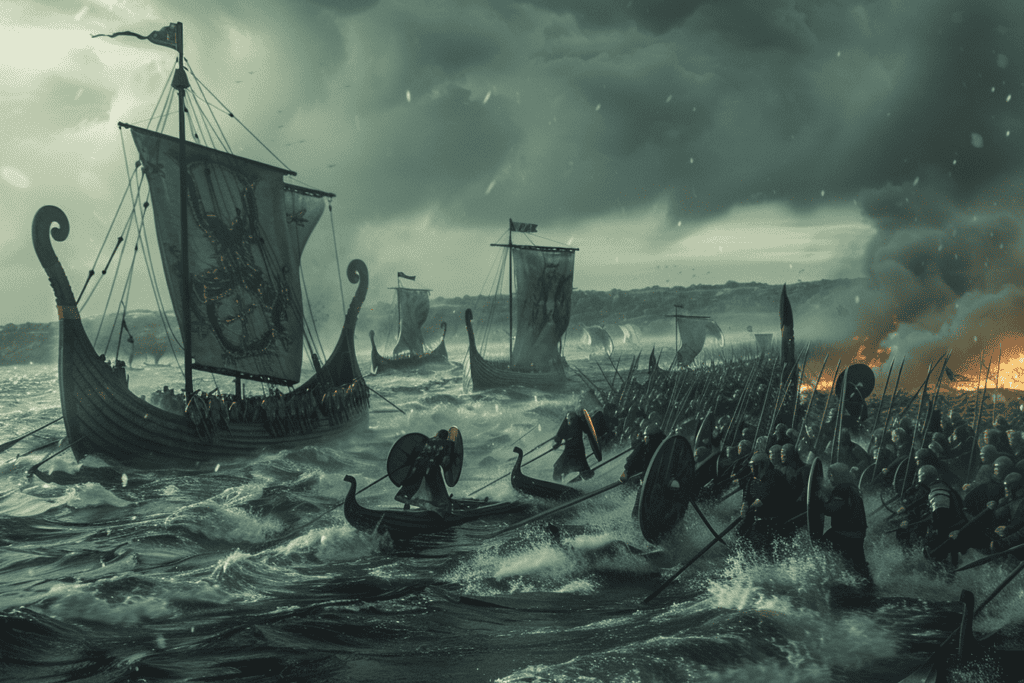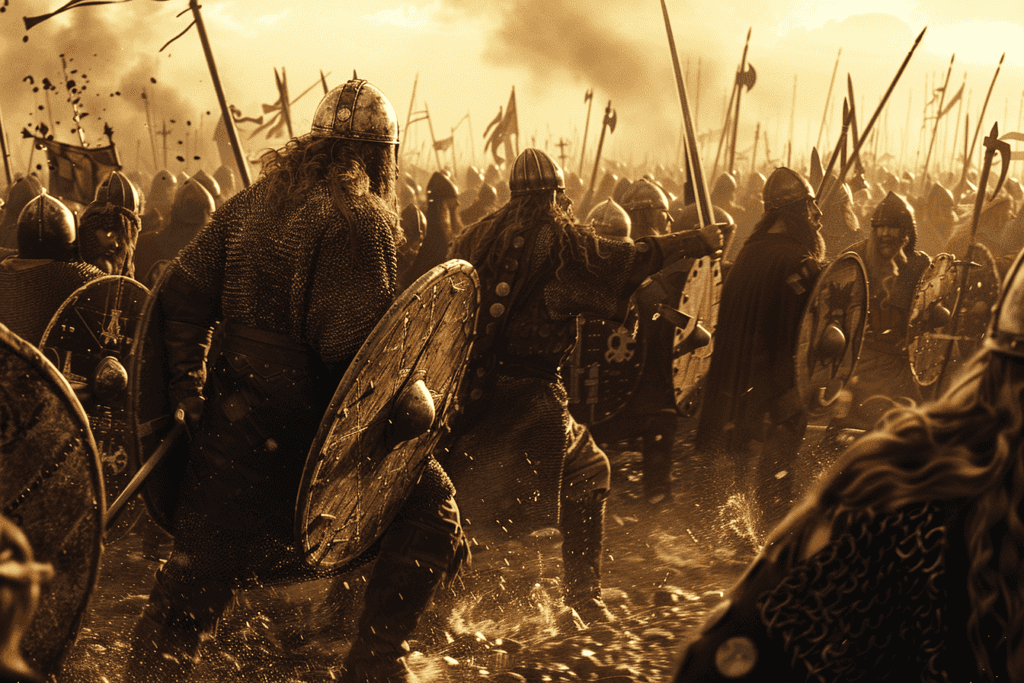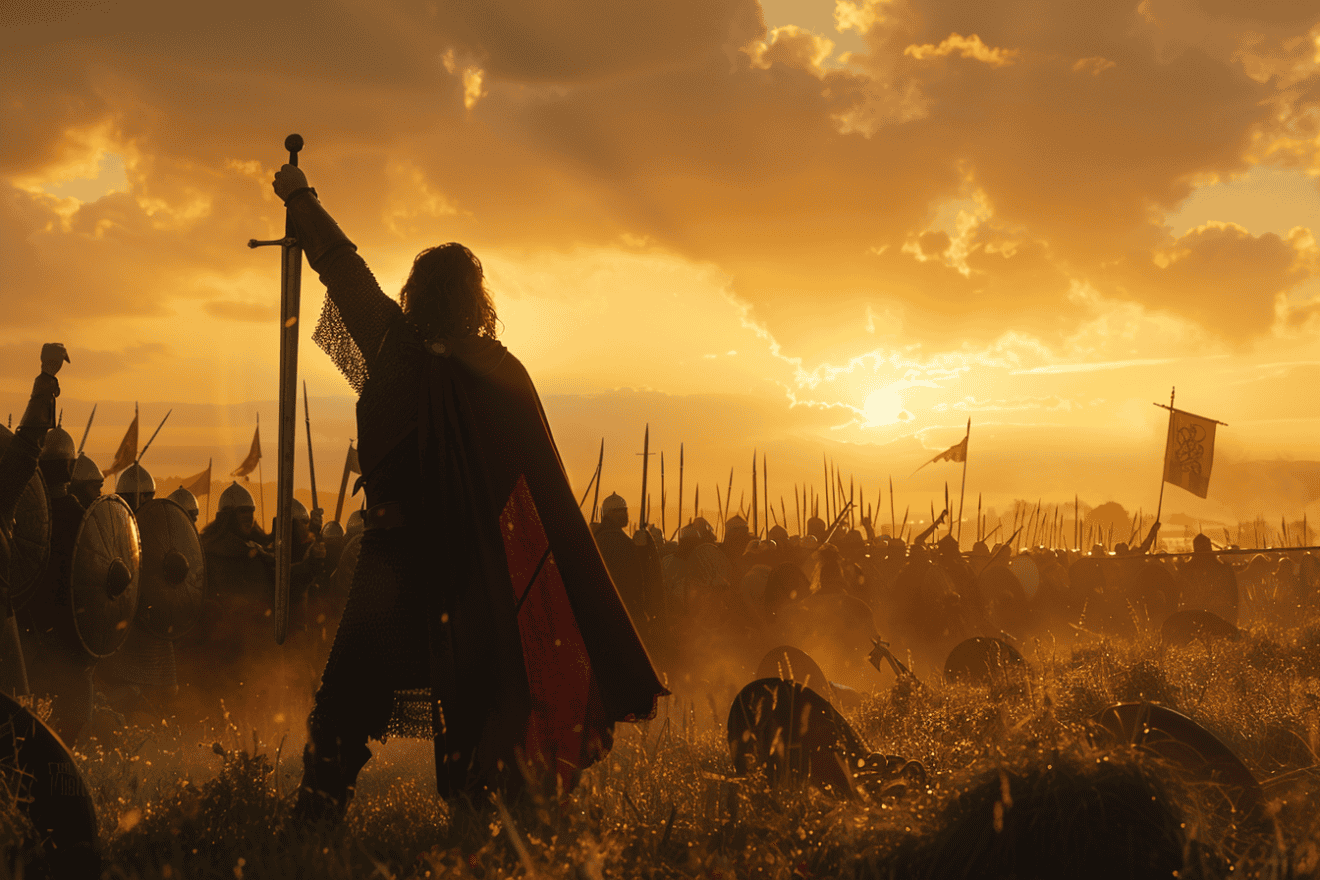In the late 9th century, England was under attack by Viking invaders.
These Norse warriors had been raiding the English coast for decades, and in 865 they began to establish permanent settlements in the country. The Vikings quickly conquered much of England.

Alfred was a skilled warrior and leader, and he immediately set about organizing his forces to resist the Viking invaders.
He built a network of fortified towns and established a new system of military service that required all able-bodied men to serve in the army. Despite these efforts, the Vikings continued to win battles and gain territory.
By 878, they had besieged Alfred in his stronghold at Chippenham.
It was at this point that Alfred rallied his forces and launched a surprise attack on the Viking camp at Edington.
The ensuing battle was fierce, but Alfred’s army was able to defeat the Vikings and force them to retreat. This victory was a turning point in the war, and it allowed Alfred to negotiate a peace treaty with the Viking leader, Guthrum.
The treaty established a boundary between Viking-controlled territory and Alfred’s kingdom of Wessex, and it marked the beginning of a period of relative peace and stability in England.
Alfred the Great: Early Life and Ascension to the Throne

Alfred the Great was born in 849 AD in the kingdom of Wessex, the youngest son of King Aethelwulf. As a child, he was educated in the arts and sciences, and his love for learning would shape his reign as king.
Alfred’s early years were marked by the Viking invasions that had begun in the 790s. He witnessed firsthand the destruction and chaos wrought by the Vikings, and this experience would shape his vision for Wessex.
Alfred’s ascension to the throne was not straightforward. He had three older brothers who all ruled Wessex before him: Aethelbald, Aethelbert, and Aethelred. When Aethelred died in 871, Alfred was only 22 years old.
He was not the obvious choice for king, but he was a natural leader and had already shown himself to be a skilled military commander.
Alfred’s Vision for Wessex
When Alfred became king, Wessex was under attack from the Vikings. In 878, the Vikings captured the town of Chippenham, and Alfred was forced to flee into the marshes of Somerset. It was there that he regrouped his forces and began planning his counterattack.
He knew that he needed to create a new kind of army, one that could fight the Vikings on their own terms.
Alfred’s vision for Wessex was not just about military strategy. He believed that education and culture were just as important as warfare. He wanted to create a kingdom that was prosperous, stable, and civilized.
To achieve this, he founded schools, encouraged the translation of books into English, and promoted the arts and sciences.
The Viking Invasion and the Great Heathen Army

The Viking invasion of England began in 865 AD when a large force of Vikings, known as the Great Heathen Army, landed on the Isle of Thanet in Kent. The army was led by three Viking kings, Ivar the Boneless, Halfdan Ragnarsson, and Guthrum. The Viking army quickly established a stronghold in Northumbria and began to raid and conquer other parts of England.
The Siege of Chippenham
In 878 AD, the Viking army under the leadership of Guthrum laid siege to the town of Chippenham in Wiltshire. King Alfred the Great, who was leading the Anglo-Saxon forces, was caught off guard and forced to flee with his small army into the marshes of Somerset. The Vikings captured Chippenham and continued their campaign of conquest.
Retreat to Athelney
King Alfred the Great used the marshes of Somerset to his advantage, building a stronghold on the island of Athelney. From there, he launched a series of guerrilla attacks on the Viking army, cutting off their supply lines and weakening their forces. Alfred also used this time to strengthen his own army and build alliances with other Anglo-Saxon kingdoms.
After several months, Alfred emerged from Athelney with a larger and stronger army and engaged the Viking army in a decisive battle at Edington. With his superior tactics and leadership, Alfred was able to defeat the Viking army and force them to retreat. This victory marked a turning point in the Viking invasion of England and paved the way for Alfred to establish a unified Anglo-Saxon kingdom.
The Battle of Edington and Its Aftermath

The Battle of Edington was a turning point in the Viking invasions of England. In 878 AD, the Viking army led by Guthrum faced off against the forces of Alfred the Great near the town of Edington in Wiltshire.
Alfred’s army was outnumbered, but he managed to secure a decisive victory. The battle marked the first time that a Saxon king had defeated a Viking army in a pitched battle.
Alfred’s victory at Edington was the result of several factors. He had managed to rally a well-trained and disciplined army, which was able to withstand the Viking onslaught. He also had the advantage of fighting on familiar terrain, which allowed him to deploy his troops effectively.
Finally, Alfred’s use of a defensive strategy, which included the use of shield walls, proved to be highly effective against the Viking charge.
The Treaty of Wedmore and Guthrum’s Baptism
Following his defeat at Edington, Guthrum was forced to sue for peace. He agreed to sign the Treaty of Wedmore, which recognized Alfred as the king of Wessex and established a boundary between the Viking-controlled territories and the rest of England. The treaty also required Guthrum to convert to Christianity and be baptized.
Guthrum’s baptism was a significant event, as it marked the first time that a Viking leader had converted to Christianity. It also helped to establish a lasting peace between the Saxons and the Vikings. The treaty allowed the Saxons to consolidate their power in the south, while the Vikings were able to maintain their hold on the north and east.
Alfred’s Legacy and the Unification of England

Military Reforms and the Burh System
Alfred the Great’s legacy was not only limited to his military victories against the Vikings, but also his military reforms and the establishment of the Burh system.
The Burh system was a network of fortified towns and cities strategically placed across the country to provide protection against Viking invasions. The Burhs also served as centers of trade and commerce, which helped to stimulate the economy.
Under Alfred’s leadership, the Anglo-Saxon army underwent significant reforms. He introduced a system of conscription, which required all able-bodied men to serve in the army for a portion of the year.
This helped to ensure that the army was always ready for battle. He also established a standing army, which was made up of professional soldiers who were paid to serve year-round.
Cultural and Educational Contributions
Alfred’s contributions to education and literacy were also significant. He believed that education was essential for the development of a strong and unified kingdom.
He established schools and encouraged the translation of important texts into English. This helped to promote literacy and the spread of knowledge.
Alfred also commissioned the Anglo-Saxon Chronicle, which was a historical record of events in Anglo-Saxon England. The Chronicle was written in Old English and provided a detailed account of events in the kingdom. It was an important tool for promoting unity and a sense of national identity.
Alfred’s legacy was not limited to his military and cultural contributions. He is also remembered for his efforts to unify England.
He was the first king to be referred to as the “King of the Anglo-Saxons,” which reflected his efforts to bring together the various Anglo-Saxon kingdoms under his rule.










Add Comment